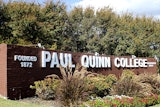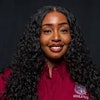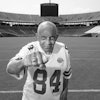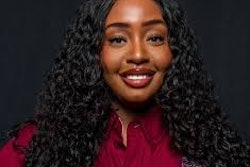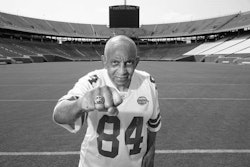As student-athletes start competing in the 2021-22 school year, in addition to training, competition, classes and study time, they are now able to explore ways to capitalize on their name, image and likeness (NIL).
After years of requests, demands, litigation, exploration, legislation and frustration, the National Collegiate Athletic Association (NCAA) announced in June the adoption of an interim policy that gave college athletes the opportunity to benefit from their NIL. Student-athletes can engage in NIL opportunities consistent with the state laws of where their institution is located and are required to report NIL activities to their institution. They may retain an agent or attorney.
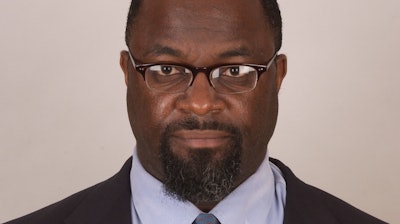 Dr. Fritz Polite
Dr. Fritz Polite
“It creates a platform where every student that participates in college athletics has to start looking at themselves as a brand, and that in itself is very important, because it changes and empowers them,” says Dr. Fritz Polite, assistant vice president of opportunity development at Shenandoah University, where he teaches marketing and brand management.
As the early days of student-athletes seeking ways to benefit from their NIL unfold, the NCAA will continue to work with Congress on a national law that provides institutions and student-athletes a consistent set of reasonable rules.
Gloria Nevarez, commissioner of the West Coast Conference (WCC), says she supports the ability of student-athletes to monetize their NIL, but she is concerned that, without a set of national guidelines and guardrails, people are operating in wildly uncertain territory.
“In general, it’s going to be a good thing for student-athletes and we will figure it out. It’s just going to be a little hectic until we get there,” Nevarez says.
New possibilities
DeShon Foxx, assistant athletic director for student success, inclusion and equity at Shenandoah University, played football at the University of Connecticut when an NCAA video game came out featuring student-athletes who received no compensation for their inclusion.
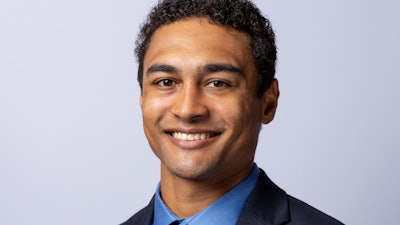 DeShon Foxx
DeShon Foxx
With more than 25 years of experience as a transactional sports lawyer, Ivan Parron is one of only 30 sports attorneys licensed by the NCAA and allowed to work with student-athletes without jeopardizing their eligibility.
“Whenever you have anything related to a personal services contract, which is unregulated, it opens up opportunities and exploitation,” says Parron. “If they have an individual like myself, an agent or a lawyer representing them, then it’s basically our job to make sure they’re not exploited.”
College athletes with a large social media presence are going to see sponsorship opportunities, and this includes female student-athletes as well as men in non-revenue generating sports, like those played in the Olympics, says Parron. Hosting sport camps presents another opportunity for student-athletes to generate revenue.
“What I would advise from the institutional perspective is to establish some kind of guidelines for each institution,” Parron says. “Focus on it so that everybody is on the same page and eliminate a little bit of this wild, wild West approach that we’re in the midst of right now. From an athlete perspective, I would say make sure to never sign anything unless you have counsel review it.”
Equity issues
The U.S. Supreme Court recently ruled against the NCAA on the restriction of education-based benefits in NCAA v. Alston, such as post-eligibility internships and scholarships for student-athletes, as it relates to student-athletes receiving outside compensation. This decision did not address NIL or pay-for-play, but there is concern that this further disadvantages institutions outside of the Power Five conferences.
If anything, the opportunities to be a big fish in a little pond might be enticing to some student-athletes, thus NIL levels the playing field a bit, says Polite.
Nevarez doesn’t foresee the recent ruling or NIL changes as adding any additional disadvantages for schools in the WCC or other smaller conferences.
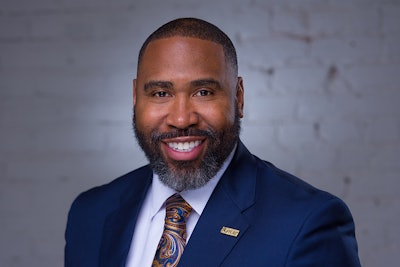 Dr. Jason Cable
Dr. Jason Cable
“When you start looking at the brand of our institutions and the trajectory of our conference, it’s more attractive now than ever,” says Cable. “When you add on NIL, you’re getting student-athletes to come to a brand that is moving forward and you’re giving them the opportunity to benefit off of that brand and also their skills.”
Eugene Marshall Jr., athletic director at Hampton University, feels neither the Supreme Court decision nor NIL will negatively impact recruiting for the historically Black university in Virginia because Hampton is a high profile institution with an excellent academic pedigree.
Should the IGNITE HBCU Excellence Act pass Congress and become law, then investment into infrastructure will help HBCUs improve athletic facilities and be more competitive in intercollegiate athletics. “It levels the playing field so that athletes will look at where they can get the best education and where they can have the best student-athlete experience,” says Marshall.
Student-athlete perspective
“When we talk about … the specific social demographic [of many student-athletes], $300 to $500 can change lives,” says Foxx. “It is allowing student-athletes to participate in the free market because they have a specific skill set that can be monetized.”
Recent Howard University graduate Tiffany Hunt is working as a marketing coordinator for Village Marketing, a company that serves as a middleman between brands and social media influencers. The former lacrosse player and outgoing president of Howard’s student-athlete advisory committee took the position to learn more about how to build her personal brand and also be a well-informed source for student-athletes looking to monetize NIL.
“A lot of student-athletes have a tremendous following,” Hunt says. “[They feel] they should have the right to make money if they’re putting out their own content, such as someone running their own Instagram or TikTok or Twitter account.”
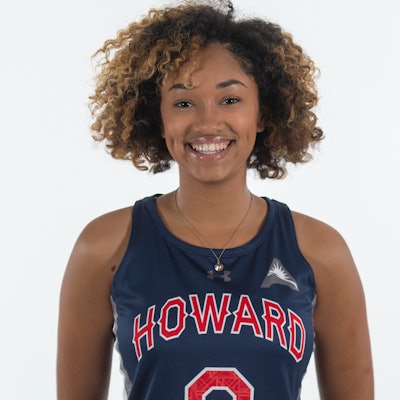 Tiffany Hunt
Tiffany Hunt
Some influencers have managers, but Parron says, unless there is significant money involved, an agent or manager might not be interested. Hunt suggests all contracts be reviewed by an attorney and counseling should be made available to student-athletes on NCAA rules as well as fair and reasonable compensation.
The SWAC has been preparing its member institutions for NIL for a couple of years leading up to the NCAA issuing its interim policy and informing institutions of available resources. Several of the institutions have partnered with organizations that review contracts and make sure student-athletes are taking part in appropriate and non-exploitive NIL activities.
What happens next
“Right now, I think there’s a hesitancy to put any protections or restrictions on this, lest we run afoul of antitrust,” Nevarez says. “Most of our institutions are leaning in heavily to education and training and really trying to get these student-athletes to understand what is and isn’t permissible and how this works, which is difficult in an environment where we’re not yet sure how it all works.
“The nice thing is we are aligned in that we want what’s best for the student-athletes,” she continues. “We don’t want them to get taken advantage of and we want them to remain eligible.”
Polite says one of the most important things to teach student-athletes is that they are personal brands.
“How you want that brand to be perceived will impact not only your ability or inability to make money, but also your own personal holistic development,” Polite says. “Now they realize that it is about them outside of their physical capabilities. It’s about the intellectual capabilities as well. You create more of a holistic model rather than a one-dimensional model that you’re an athlete.”
Foxx emphasizes the importance of providing information on financial literacy. When universities show their support of NIL by providing courses for student-athletes on branding and marketing, it will empower them to be their best.
“What I hope to see happen is an intersection between NIL and education that we can utilize to help prepare student-athletes for when they graduate,” Foxx says.
Nevarez praises two of the universities in the WCC that are directly addressing NIL issues. Gonzaga University has introduced Next Level, a comprehensive program that will provide education and tools to build personal brands. It will focus on five key areas: personal brand management, financial literacy, business and entrepreneurship, social media and NIL legislation. Brigham Young University has Built4Life, which focuses on sustaining success in the classroom and in sports while monetizing NIL.
The compliance office at Hampton will carefully review NIL and then the athletic department will provide the student-athletes with as much education and guidance as possible.
“As long as they follow the interim guidelines of the NCAA and it doesn’t interfere with classes, practice or games, we’re not going to try to put people in a box,” says Marshall. “We’re going to work with them, but at the same token, we can’t tell them what they can and cannot do. The NCAA has set up interim guidelines. Our conference [the Big South] has set up some interim guidelines as well and we’re working on ours so that we’ll all be in sync.”
This article originally appeared in the September 30, 2021 edition of Diverse. Read it here.
